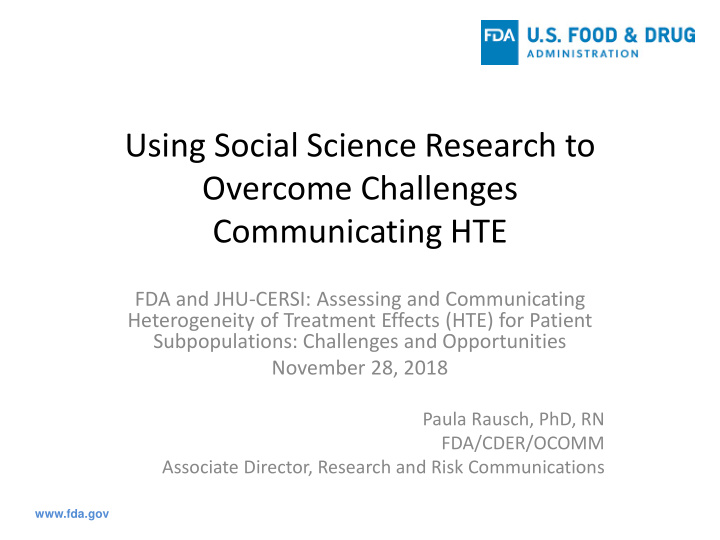



Using Social Science Research to Overcome Challenges Communicating HTE FDA and JHU-CERSI: Assessing and Communicating Heterogeneity of Treatment Effects (HTE) for Patient Subpopulations: Challenges and Opportunities November 28, 2018 Paula Rausch, PhD, RN FDA/CDER/OCOMM Associate Director, Research and Risk Communications www.fda.gov
• No conflicts of interest to report This presentation reflects the views of • the author and should not be construed to represent FDA’s views or policies. How can social science research be used to help overcome some of the challenges of communicating HTE? 2 www.fda.gov
• Behavioral and social sciences research is a large, multifaceted field, encompassing a wide array of disciplines. Focuses on understanding of behavioral or • social processes, or on the use of these processes to predict or influence health outcomes or risk factors. • “Behavioral" refers to: What is – overt actions – underlying psychological processes such as Social and cognition, emotion, temperament, and motivation – biobehavioral interactions. Behavioral The term “social" encompasses: • – Socio cultural/economic/demographic status Science – biosocial interactions – Various levels of social context from small groups Research? to complex cultural systems & societal influences. Uses various methodological approaches. • (NIH OBSSR, ND) • Basic and applied research. • Several key cross-cutting themes characterize social and behavioral sciences research, including: The search for general principles of behavioral and – social functioning; – Emphasis on individual variation, and variation across sociodemographic categories such as gender, age, and sociocultural status. 3 www.fda.gov
Social and Behavioral Science Methods Quantitative Qualitative Literature reviews Primary surveys: Questionnaires Web-based (computer and cell phone) • Direct mail • • Email Environmental scans/“gray” literature Primary surveys: Interviews • In person Telephone • Virtual/remote • Social media research Secondary analysis of previously gathered survey data Focus groups Experimental studies In person • • Virtual/remote Interviews • In person Telephone • Virtual/remote • Workshops & other guided listening sessions 4 Direct observation www.fda.gov
Knowledge, understanding, learning, recall Message effects Self-efficacy/crisis efficacy Some Emotions General Risk perceptions, including risk severity and susceptibility Outcomes Decision-making of Interest Experiences Opinions/attitudes Actions/behavioral Intentions Formatting www.fda.gov 5
Social Media Research An exploratory Aggregates social data from millions of social and online sites • without practical limitations. research method that Qualitative and quantitative data can be collected on which • involves using tools thematic, spatial, and temporal analyses can be conducted. and techniques to G ain insight on attitudes, opinions, thoughts and behaviors on – certain topics extract and analyze – Identify emerging topics & trends unstructured data from – Obtain real-time overview of people’s reactions during a specific event (e.g., valsartan recall) or over time conversations and – Identify potential influencers & opinion makers across key platforms discussions occurring • Provides an opportunity to quickly collect a wide diversity of on social media information produced by a large and heterogeneous group of channels and the people from geographically diverse areas. Internet that can Data collectable over varying periods of time (including • longitudinally). enhance Allows SM researchers to build a broader, more-detailed and • understanding of the potentially more authentic picture of a topic or issue. social context Focuses on people’s perspectives and meanings, in their own • surrounding expressive language. Conversations occur in virtual social settings where • topics/issues. users/posters choose to gather. Often allows more honesty and openness than might be • possible in other forms of research. 6 www.fda.gov
Thank You Paula.Rausch@FDA.HHS.gov 301-796-3121 7 www.fda.gov
Recommend
More recommend